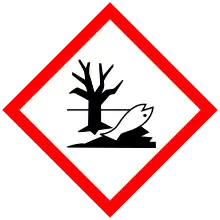Tetrabutylammonium bromide
Tetrabutylammonium bromide (TBAB) is a quaternary ammonium salt with a bromide commonly used as a phase transfer catalyst.[2] It is used to prepare many other tetrabutylammonium salts by salt metathesis reactions. The anhydrous form is a white solid.[3]
 | |
| Names | |
|---|---|
| Preferred IUPAC name
N,N,N-Tributylbutan-1-aminium bromide | |
Other names
| |
| Identifiers | |
3D model (JSmol) |
|
| ChEBI | |
| ChEMBL | |
| ChemSpider | |
| ECHA InfoCard | 100.015.182 |
| EC Number |
|
PubChem CID |
|
| UNII | |
CompTox Dashboard (EPA) |
|
| |
| |
| Properties | |
| C16H36BrN | |
| Molar mass | 322.368 g/mol |
| Appearance | White solid |
| Melting point | 103 °C (217 °F; 376 K) Decomposes at 133C[1] |
| Hazards | |
| Occupational safety and health (OHS/OSH): | |
Main hazards |
Harmful |
| GHS labelling: | |
  | |
| Warning | |
| H302, H315, H319, H335, H411, H412 | |
| P261, P264, P270, P271, P273, P280, P301+P312, P302+P352, P304+P340, P305+P351+P338, P312, P321, P330, P332+P313, P337+P313, P362, P391, P403+P233, P405, P501 | |
| Related compounds | |
Other anions |
Tetrabutylammonium tribromide, Tetra-n-butylammonium fluoride, Tetrabutylammonium chloride, Tetra-n-butylammonium iodide, Tetrabutylammonium hydroxide |
Other cations |
Tetramethylammonium bromide, Tetraethylammonium bromide |
Except where otherwise noted, data are given for materials in their standard state (at 25 °C [77 °F], 100 kPa).
Infobox references | |
In addition to being cheap, tetrabutylammonium bromide is also environmentally friendly, has a greater degree of selectivity, is operationally simple, non-corrosive, and can be recycled easily as well.[4]
Preparation and reactions
Tetrabutylammonium bromide can be prepared by the alkylation of tributylamine with 1-bromobutane.[3]
Tetrabutylammonium bromide is used to prepare other salts of the tetrabutylammonium cation by salt metathesis reactions.[5]
It serves as a source of bromide ions for substitution reactions. It is one of a commonly-used phase transfer catalyst. As its melting point is just over 100 °C and decreases in the presence of other reagents, it can be considered an ionic liquid.[3]
Role in semi-clathrate formation
TBAB is being extensively studied as a thermodynamic promoter in the formation of semi-clathrate hydrates which greatly brings down the pressure - temperature requirement for forming gas hydrates.
See also
- Tetrabutylammonium tribromide, with an additional Br2 unit
- Tetrabutylammonium fluoride
- Tetrabutylammonium chloride
- Tetrabutylammonium iodide
References
- Applied Catalysis A: General 241 (2003) 227–233
- Henry J. Ledon (1988). "Diazo transfer by means of phase-transfer catalysis: di-tert-butyl diazomalonate". Organic Syntheses.; Collective Volume, vol. 6, p. 414
- Charette, André B.; Chinchilla, Rafael; Nájera, Carmen (2007). "Tetrabutylammonium Bromide". In Paquette, Leo A. (ed.). Encyclopedia of Reagents for Organic Synthesis. doi:10.1002/047084289X.rt011.pub2. ISBN 978-0471936237.
- Chary, M.V.; Keerthysri, N.C.; Vupallapati, S.V.N.; Lingaiah, N.; Kantevari, S. (2008). "Tetrabutylammonium bromide (TBAB) in isopropanol: An efficient, novel, neutral and recyclable catalytic system for the synthesis of 2,4,5-trisubstituted imidazoles". Catal. Commun. 9: 2013–2017.
- Klemperer, W. G. (1990). "Tetrabutylammonium Isopolyoxometalates". Inorganic Syntheses. Inorganic Syntheses. Vol. 27. p. 74–85. doi:10.1002/9780470132586.ch15. ISBN 9780470132586., Bojes, J.; Chivers, T.; Drummond, I. (1978). "Heptathiazocine(Heptasulfurimide) and Tetrabutylammonium Tetrathionitrate". Inorganic Syntheses. Inorganic Syntheses. Vol. 18. p. 203–206. doi:10.1002/9780470132494.ch36. ISBN 9780470132494., Ceriotti, A.; Longoni, G.; Marchionna, M. (1989). Bis(Tetrabutylammonium) Hexa-μ-Carbonyl-Hexacarbonylhexaplatinate(2−), [N(C4H9)4]2[Pt6(CO)6(μ-CO)6]. Inorganic Syntheses. Vol. 26. p. 316–319. doi:10.1002/9780470132579.ch57.;Christou, George; Garner, C. David; Balasubramaniam, A.; Ridge, Brian; Rydon, H. N. (1982). "9. Tetranuclear Iron-Sulfur and Iron-Selenium Clusters". Tetranuclear Iron-Sulfur and Iron-Selenium Clusters. Inorganic Syntheses. Vol. 21. p. 33–37. doi:10.1002/9780470132524.ch9. ISBN 9780470132524..